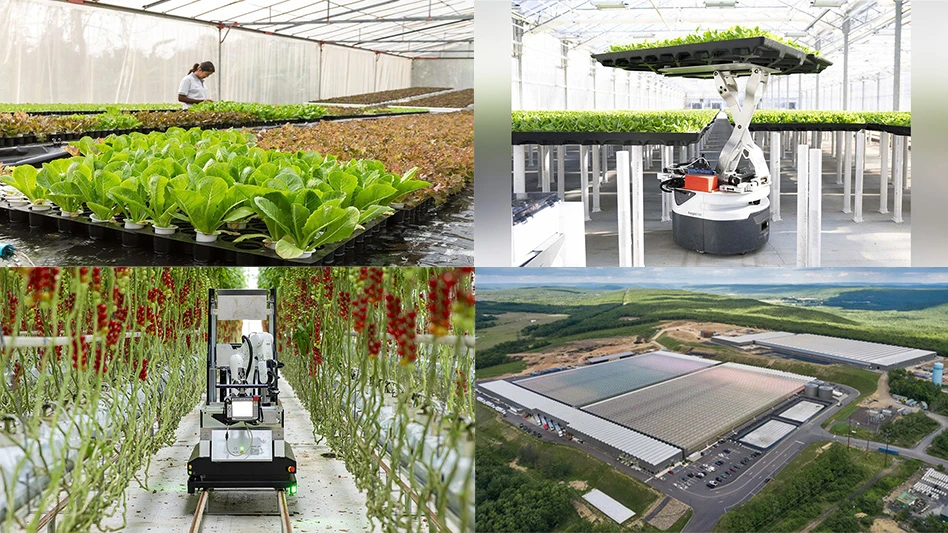
 Imagine a greenhouse covering that stretches from Baltimore to Philadelphia. That’s how much poly covering one of Monrovia’s nurseries recycles each year. That's plastic that would otherwise end up in a landfill. Multiply this number by the covering used for over 30,000 commercial greenhouse operations in this country and you can imagine how much plastic could potentially end up in a landfill. And this doesn’t include the tons of plastic used for growing a greenhouse crop: propagation trays, injection flats, and various size pots.
Imagine a greenhouse covering that stretches from Baltimore to Philadelphia. That’s how much poly covering one of Monrovia’s nurseries recycles each year. That's plastic that would otherwise end up in a landfill. Multiply this number by the covering used for over 30,000 commercial greenhouse operations in this country and you can imagine how much plastic could potentially end up in a landfill. And this doesn’t include the tons of plastic used for growing a greenhouse crop: propagation trays, injection flats, and various size pots.
Fortunately, most of the plastic and poly used in the horticulture industry doesn’t end up in one big heap in already burgeoning landfills. Many growers in nurseries and greenhouses have stepped up to the task of recycling, which is good news for customer relations and Mother Earth.
“The main reason we recycle is to keep it out of the landfills,” says Mark Hixson, customer service coach with Monrovia Growers East Region.
Hixson says that recycling is the right thing to do and a cost of doing business, even though you will get paid for your recyclables. Monrovia uses an expensive baler to bale up the poly that comes off their houses. It is then shipped overseas. The money they collect for the material only partially offsets the cost to handle the product, says Hixson; but again, making money isn’t the incentive to recycle.
“We started it to be greener and people do business with companies they like,” says Hixson. He said they also recycle all of their plastic containers, including ones that come back from the very garden centers they serve.
“It gives independent garden centers an incentive to be green; we're offering the garden center a service,” says Hixson of the arrangement.
He says there is no way around the labor costs associated with recycling, though he did offer a couple of suggestions to make it as efficient, and as cost effective, as possible. Namely, keep the plastic collected from the retailers off-site until it can be picked up, and get rid of the product (recyclables) as soon as possible. In other words, don’t keep trays and the like sitting around where they can be battered and blown around by the wind.
Closed-loop recycling
The pots and propagation containers that Monrovia uses in production are picked up by East Jordan, Mich.-based East Jordan Plastics (EJP), a company that knows a thing or two about recycling. “There is value to these containers,” says Nathan Diller, EJP recycling manager. “These containers can be recycled again and again.”
|
Guidelines for recycling horticultural containers Most horticultural growing containers can be recycled, i.e., flats, inserts, propagation trays, etc.
For more information about East Jordan Plastics: www.eastjordanplastics.com To find out more about Elle Plugs: http://www.blackmoreco.com/ellegaard.html
|
EJP, a family-owned business that started manufacturing wooden flats in 1947, is now one of the largest horticulture thermoformers in North America. They’ve created a thriving business out of turning discarded growing containers into attractive containers, growing pots, plug and propagation trays, plant flats, and inserts.
“We can turn those (growing containers) into clean regrind that can be used over and over again to manufacture new containers,” says Diller. “The growers save on landfill costs and we pay for the material which should at least offset their labor in consolidating the material.”
Diller says a lot of the material they receive makes its way back from retailers like Home Depot, Lowes, and independent garden centers, where bins are put out for consumers. He says much of what comes back via the retailers is plastic from the original grower, as retailers consolidate containers and recycle trays used to hold six-packs and various size pots.
“We recycle over 12 million pounds of used horticultural containers annually and the number continues to grow,” says Diller. “The horticultural containers that we recycle are used to manufacture new horticultural containers, so this is an example of closed-loop recycling at its finest.”
Recycling categories
The material that EJP and other recyclers can accept falls into three categories:
Polystyrene. Look for recycling code P.S. #6. These include shuttle trays®, flats, inserts, some pots 5” and smaller, and most plug and propagation trays, liners and inserts.
Polypropylene. Indicated with recycling code P.P. #5 and includes shuttle trays®, flats and pots 5”or larger and most injection molded containers.
High density polyethylene labeled with recycling code H.D.P.E. #2. These include mostly large blow molded or injection molded nursery pots.
“Recycle” into the earth
An alternative to plastic containers is a thin, biodegradable pot that can be shipped and sold at garden centers. For several years now, Walters Gardens, Inc., in Zeeland, Mich., has used Elle Plugs for all of the perennial plants they send to their customers. Susan Martin, director of marketing for Walters and an avid plant person herself, is impressed with the plugs, which they manufacture with their own machine onsite.
“It is certainly an excellent alternative to plastic pots,” says Martin. “We used to grow most of our plug products in plastic pots. Since switching to the Elle Plugs, not only are we growing greener without all of that plastic but crops finish for us up to 30 percent faster now, which means we also use less water, heat, and fertilizer in production.”
With Elle Plugs, or a similar biodegradable pot, the material doesn’t have to be collected, palletized and baled, but is instead recycled as it breaks down in the soil.
“Once the customer pots the Elle Plugs up into pots, the paper will degrade further,” says Martin.
“The goal is to have the paper fully degraded once the home gardener plants the plants in their garden.”
Of course, these biodegradable pots may not be suitable for all phases of plant production, especially when growing nursery stock in 2- to 3-gallon containers or planting thousands of petunias in propagation trays. Growers will ultimately choose the container most fitting for their operation.
More than dollars and cents
Although growers need to recycle in the most efficient, cost effective manner as possible, in the end it’s about more than dollars and cents. “It depends on your commitment to the earth, it costs us labor to do this,” says Hixson. “Have the right mindset, don’t go into it thinking you’ll make money, rather think about the impact on the environment.”
Right now, what’s good for the environment is good for customer relation. And that always makes sense.
Neil Moran is a horticulturist and freelance writer based in Sault Ste. Marie, Mich.

Explore the June 2014 Issue
Check out more from this issue and find your next story to read.
Latest from Produce Grower
- AeroFarms reveals patented technology for microgreen production, prompting talk of expansion
- Cox Farms partners with Feeding America to tackle food insecurity
- Ethical labor practices supported by third-party certification programs
- Spotlight on strawberry production
- Relationship building
- Growing small to trial leafy greens
- IFPA expands team, launches strategic plan
- Downy mildew






